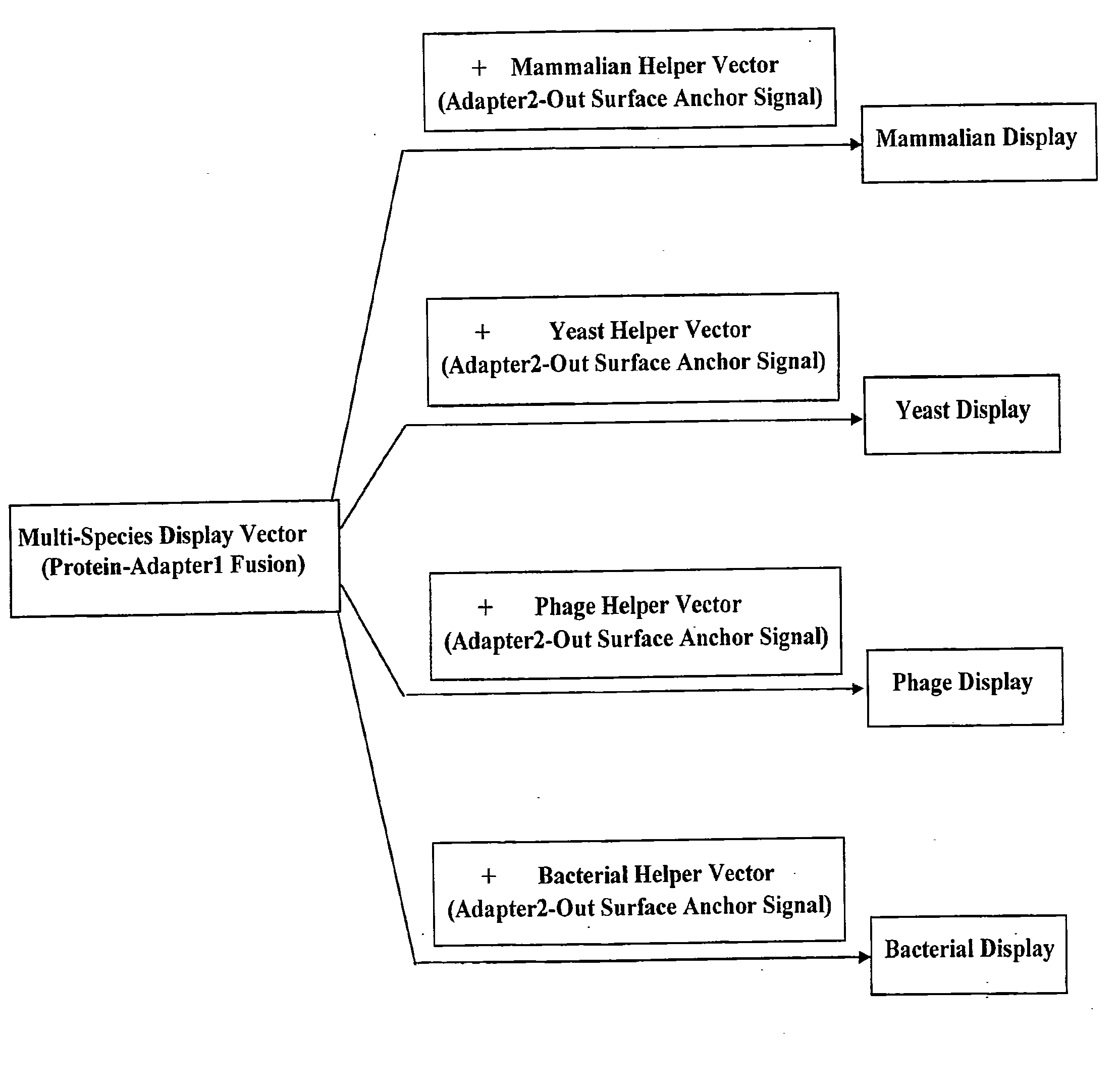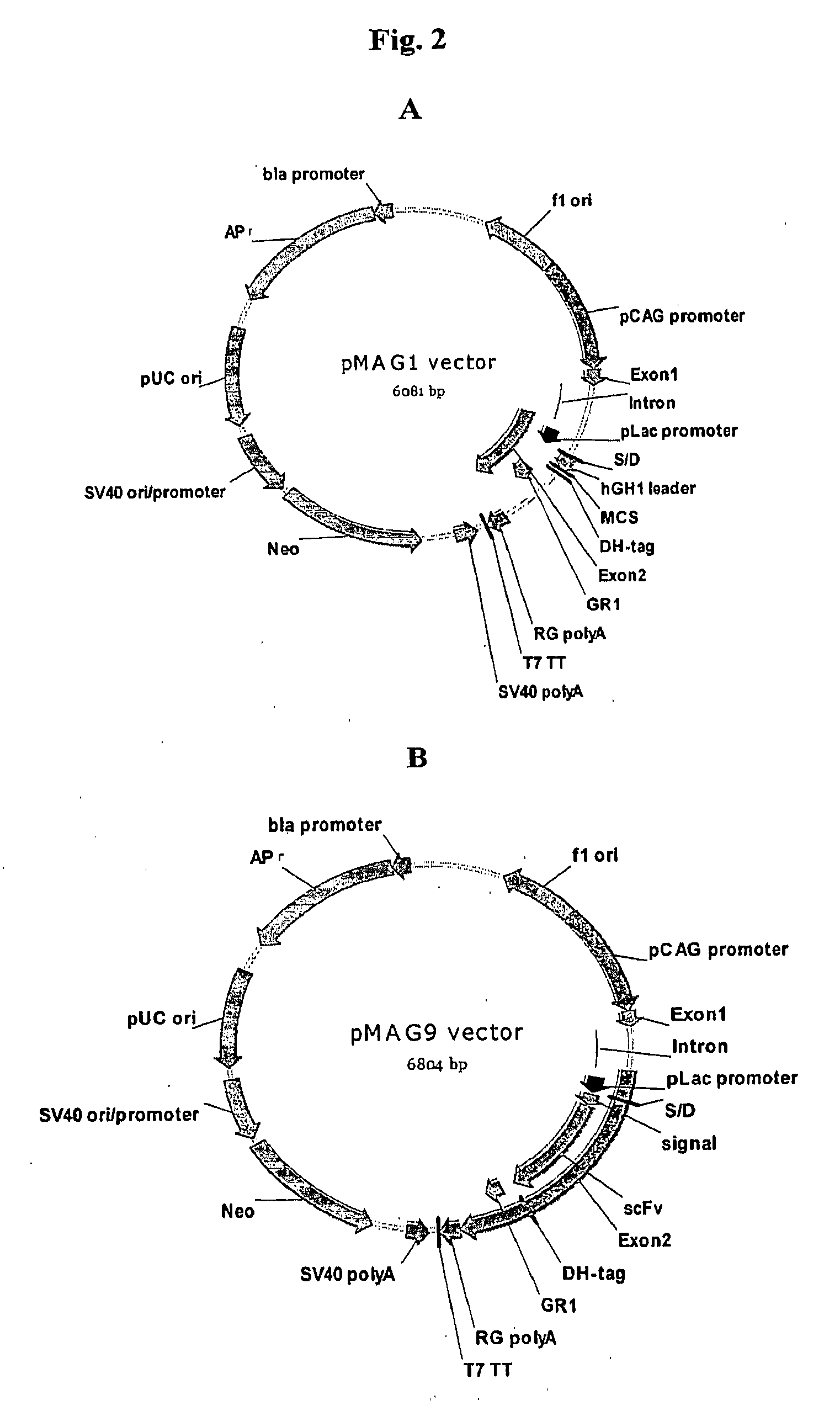Cross-Species and Multi-Species Display Systems
a multi-species, display system technology, applied in the field of protein display, can solve the problems of large-scale use of eukaryotic host cells for protein display, inability to perform the full range of post-translational modifications, and inability to functionally express prokaryotic host cells, etc., and achieve the effect of small size of yeast display library
- Summary
- Abstract
- Description
- Claims
- Application Information
AI Technical Summary
Benefits of technology
Problems solved by technology
Method used
Image
Examples
example 1
Display Vector pMAG1
[0125]The vector pMAG1 exemplifies an expression vector suitable for use in a cross-species display and production protocols in which a polypeptide library is displayed and / or produced in a prokaryotic display system (phage and bacterial cells) and subsequently displayed and / or produced in a eukaryotic display system (mammalian cells).
[0126]pMAG1 vector, which is depicted in FIG. 2A, is built on the backbone of commercial vector pUC19 by insertion at EcoRI and PciI sites with a fully synthetic DNA fragment of 3799 bp. This fully synthetic DNA comprises the following elements: (1) f1 ori for phage package; (2) a cross-species expression cassette, in which the expression of the adapter GR1 fusion is driven by two promoters: a CNV enhancer / Chicken β-actin promoter for mammalian cells and pLac promoter for bacterial cells. The sequence of multiple cloning sites (MCS) for gene of interest cloning is built in the downstream of a signal sequence from human growth hormon...
example 2
Display Vector pMAG9
[0128]The vector pMAG9 (SEQ. ID. NO: 2) was derived from pMAG1 vector by inserting a gene encoding a anti-VEGF antibody scFv downstream of signal sequence by SacI and NotI sites. A skilled artisan will readily appreciate that pMAG9 can be used to display a library of coding sequences encoding antibodies of various formats. The scFv gene was amplified by PCR. Briefly, the pABMX268 (US patent application 20040133357A1) DNA was used as template, the PCR primers were listed below: AM-90: 5′-AGTCAGGTAAGCGCTCGCGCTCCGAGGTGCAGCTGGTGCAGAGCG-3′ (SEQ ID NO: 3) and AM-91: 5′-ATGACCTCCTGCGTAGTCTGGTACGTC-3 (SEQ ID NO: 4). The PCR reactions were prepared by mixing template / primers solution with pfuUtra Hotstart PCR Master mix according to the instruction manual from Stratagene. Thermal cycle conditions were set as following: 3 minutes denaturation at 94° C.; 30 cycles of 45 second denaturation at 94° C., 45 second annealing at 55° C., and 1 minute 30 second extension at 72° C.;...
example 3
Phage Helper Vector GMCT
[0130]Vector GMCT was constructed from a well-characterized vector, namely M13KO7 (from Amersham Pharmacia) in two steps according to the procedure detailed below. In the first step, the KpnI site was introduced into the gene III signal sequence of KO7 helper phage vector by PCR-based site-directed mutagenesis. This silent mutation did not change the coding sequence of the pIII signal peptide. The KO7 genome was amplified by PCR using the following primers which contain KpnI site: p3KN1:
5′-TTTAGTGGTA CCTTTCTATTCTCACTCCGCTG-3′ (SEQ ID NO: 5) and p3KN2: 5′-TAGAAAGGTACCACTAAAGGAATTGCGAATAA-3′ (SEQ ID NO: 6). These primers share partial sequence homology to the gene III signal sequence. PCR was performed in a 100 ul reaction mixture containing 100 ng KO7 vector DNA, 20 pmol each of primers, 250 uM dNTP, and 1×pfu buffer and pfu DNA polymerase (Stratagene). The reaction mixture was initially incubated at about 96° C., and then subjected to 15 cycles of PCR in a th...
PUM
| Property | Measurement | Unit |
|---|---|---|
| temperature | aaaaa | aaaaa |
| concentration | aaaaa | aaaaa |
| concentration | aaaaa | aaaaa |
Abstract
Description
Claims
Application Information
 Login to View More
Login to View More - R&D
- Intellectual Property
- Life Sciences
- Materials
- Tech Scout
- Unparalleled Data Quality
- Higher Quality Content
- 60% Fewer Hallucinations
Browse by: Latest US Patents, China's latest patents, Technical Efficacy Thesaurus, Application Domain, Technology Topic, Popular Technical Reports.
© 2025 PatSnap. All rights reserved.Legal|Privacy policy|Modern Slavery Act Transparency Statement|Sitemap|About US| Contact US: help@patsnap.com



